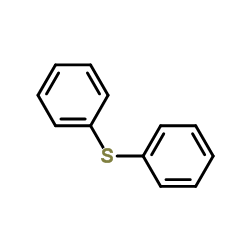Diphenylsulfid

Diphenylsulfid structure
|
Common Name | Diphenylsulfid | ||
|---|---|---|---|---|
| CAS Number | 139-66-2 | Molecular Weight | 186.273 | |
| Density | 1.1±0.1 g/cm3 | Boiling Point | 296.0±9.0 °C at 760 mmHg | |
| Molecular Formula | C12H10S | Melting Point | −40 °C(lit.) | |
| MSDS | Chinese USA | Flash Point | 128.4±15.4 °C | |
| Symbol |


GHS07, GHS09 |
Signal Word | Warning | |
|
Highly flexible sub-1 nm tungsten oxide nanobelts as efficient desulfurization catalysts.
Small 11(9-10) , 1144-9, (2015) Ultrathin tungsten oxide nanobelts are successfully synthesized via a facile solvothermal method. Sub-1 nm thickness and hydrophobic surface property endow the nanobelts with flexibility, viscosity, gelation, and good catalytic performance in oxidative desulf... |
|
|
[The preparation of antihymenolepidiasis activity of MCT-44].
Med. Parazitol. (Mosk.) (4) , 38-9, (2011)
|
|
|
Use of simple docking methods to screen a virtual library for heteroactivators of cytochrome P450 2C9.
J. Med. Chem. 50 , 1158-65, (2007) Several laboratories have demonstrated that activation of drug metabolism by P450s may occur via a mechanism that resembles allosterism from an enzyme kinetic standpoint. Because the effector drug binding site may be located in the same P450 binding pocket wh... |
|
|
Polystyrene bound oxidovanadium(IV) and dioxidovanadium(V) complexes of histamine derived ligand for the oxidation of methyl phenyl sulfide, diphenyl sulfide and benzoin.
Dalton Trans. (12) , 2185-95, (2009) Ligand Hsal-his (I) derived from salicylaldehyde and histamine has been covalently bound to chloromethylated polystyrene cross-linked with 5% divinylbenzene. Upon treatment with [VO(acac)(2)] in DMF, the polystyrene-bound ligand (abbreviated as PS-Hsal-his, I... |
|
|
HPLC analysis of 4-chlorophenyl methyl sulphide and diphenyl sulphide and their corresponding sulphoxides and sulphones in rat liver microsomes.
J. Pharm. Biomed. Anal. 27(1-2) , 315-25, (2002) Simple high performance liquid chromatography (HPLC) methods for the analysis of 4-chlorophenyl methyl sulphide (CPMS), diphenyl sulphide (DPS) and their corresponding sulphoxide and sulphone metabolites in rat liver microsomes are described. The assay method... |
|
|
Synthesis and QSPR study on environment-related properties of polychlorinated diphenyl sulfides (PCDPSs)
Chemosphere 88(7) , 844-54, (2012) Highlights ► Some PCDPS congeners were synthesized and the logKow and logk′ were determined. ► Three methods were used to establish models for predicting logKow and logk′. ► The logKow and logk′ of all PCDPS congeners were predicted based on the models. ► The... |
|
|
Acute and subacute oral toxicity of polychlorinated diphenyl sulfides in mice: determining LD50 and assessing the status of hepatic oxidative stress.
Environ. Toxicol. Chem. 31(7) , 1485-93, (2012) Polychlorinated diphenyl sulfides (PCDPSs), a series of dioxin-like compounds, have been detected in various environmental samples. However, information on the toxicity of these compounds is limited. In the present study, the toxic effects of PCDPSs were asse... |
|
|
Experimental and theoretical study on IR and NMR spectra of several tetrachlorinated diphenyl sulfides.
Spectrochim. Acta. A. Mol. Biomol. Spectrosc. 81(1) , 261-9, (2011) Tetrachlorinated diphenyl sulfides (TCDPSs) are environmentally interesting compounds. In this paper, both experimental and theoretical studies on IR and (1)H NMR as well as (13)C NMR chemical shifts of 4 synthesized TCDPSs have been carried out. The optimize... |
|
|
Molecular modeling of potential new and selective PET radiotracers for the serotonin transporter. Positron Emission Tomography.
J. Pharm. Pharm. Sci. 5(3) , 245-57, (2002) Imaging the serotonin transporter (SERT) with Positron Emission Tomography (PET) provides a useful tool for understanding alterations of the serotonergic system. However, no optimal PET radiotracer for the SERT yet exists. The main purpose of this study was t... |
|
|
Involvement of cytochrome P450 and the flavin-containing monooxygenase(s) in the sulphoxidation of simple sulphides in human liver microsomes.
Life Sci. 73(3) , 359-69, (2003) This study was conducted to examine the involvement of cytochrome P450 (CYP450) and the flavin-containing monooxygenase (FMO) in the sulphoxidation of ethyl methyl sulphide (EMS), 4-chlorophenyl methyl sulphide (CPMS) and diphenyl sulphide (DPS) in human live... |